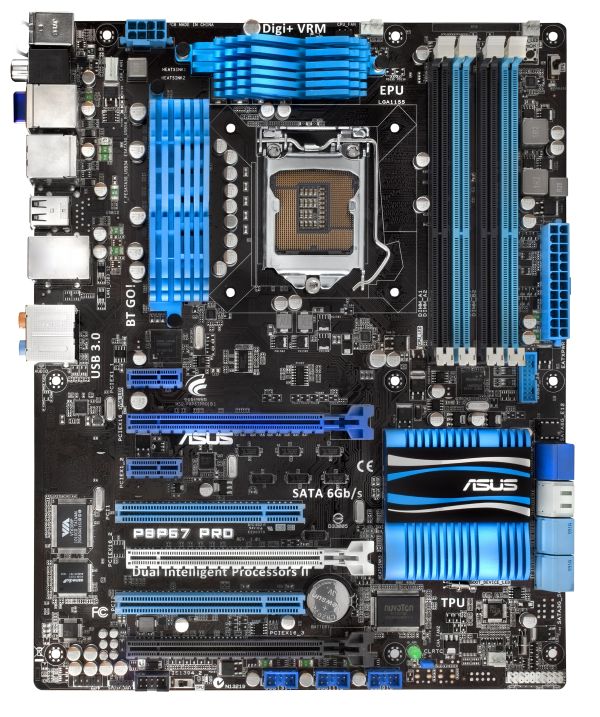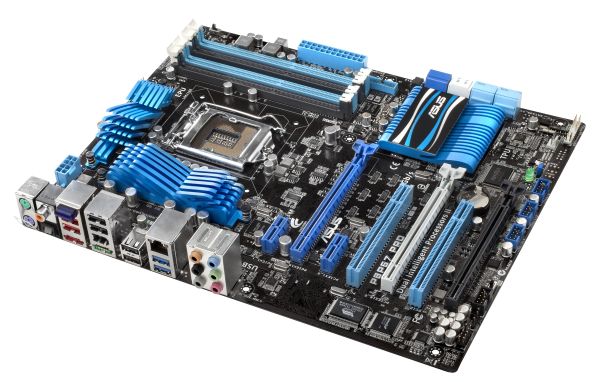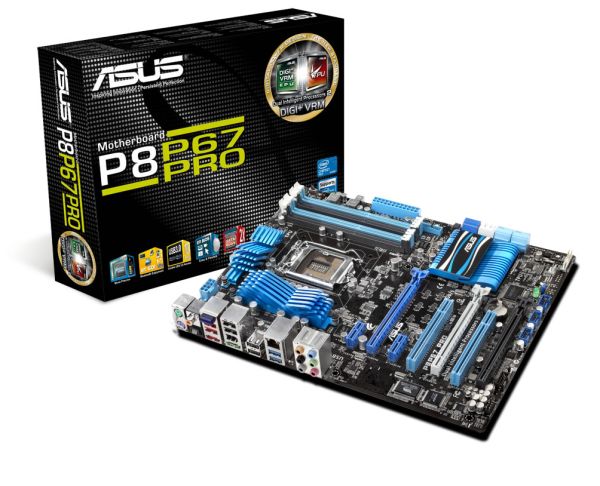The Battle of the P67 Boards - ASUS vs. Gigabyte at $190
by Ian Cutress on January 20, 2011 4:15 PM EST- Posted in
- Motherboards
- Gigabyte
- Asus
- P67
The ASUS P8P67 Pro fits near the beginning of the line-up in the ASUS launch, which in terms of ATX sized boards include the P8P67, the P8P67 Pro, the P8P67 Evo, the P8P67 Deluxe, the Sabertooth P67, the P8P67 WS SuperComputer and the top end Maximus IV Extreme. Therefore, with that in mind, we would expect to be looking at something above the base – slightly more (or better) features than the cheap boards available, enough to warrant the price difference. An overview of the P8P67 series is below:
| P8P67 Series | ||||||
| P8P67 LE | P8P67 | P8P67 PRO | P8P67 EVO | P8P67 Deluxe | ||
| Price | $140 | $160 | $190 | $210 | $235 | |
|
SATA 6 Gb/s SATA 3 Gb/s eSATA |
3 4 1 |
4 4 1 (bracket) |
4 4 2 |
4 4 2 |
4 4 2 |
|
|
CrossFireX SLI |
Yes No |
Yes No |
Yes Yes |
Yes Yes |
Yes Yes |
|
|
USB 3.0 USB 2.0 |
2 14 |
4 (2 via header) 12 |
||||
| LAN | 1 | 1 | 1 | 2 | 2 | |
| Bluetooth | No | Yes | Yes | Yes | Yes | |
Visual Inspection
ASUS have gone with the blue/white/black livery for the Pro board, with a 12+2 digital VRM design covered by slanted blue heat sinks. The socket itself is relatively clear, easily allowing large 1155/1156 CPU coolers to be fitted (remember, 1155 mounting holes are the same as 1156). The CPU fan header is located at roughly one o’clock from the socket itself, with a chassis header to the right of the DIMM slots, presumably for HDD bay type fans.
Next to this header are the EPU switch and the MemOK buttons. The EPU switch enables Energy Processing Unit, which is geared towards saving energy – this encompasses power gating certain features that are never used/used rarely, and declocking when less compute is required. The MemOK button is a physical override for overclocked memory – by holding it down until the red light comes on, at next boot, the UEFI will override the memory settings to something more suitable.
The SATA connectors come in blue (SATA 3 Gb/s), white/grey (SATA 6 Gb/s provided by the chipset) and navy blue (SATA 6 Gb/s provided by a Marvell controller). There is a USB 3.0 header also here, near the DIMM slots. These are all next to the ASUS logo and chipset cooler, which underneath have another chassis header and a green power light. This board is lacking both a debug LED and power/reset buttons on the main board, much to our disappointment.
The PCI slots are well laid out, with a PCIe 1x at the top and enough space between the first two PCIe x16 for a PCI card, meaning that at least one is available if all three PCIe x16 are occupied with dual slot cards. The black PCIe x16 slot is wired up as an x4 slot (as it shares bandwidth with the x1 slots, two USB 3.0 ports and the eSATA ports), and with a dual slot card in there, will cover most of the board USB headers.
The TPU switch is underneath the PCI slots, and performs the same function as the TurboV EVO software in the OS to optimise the system for a decent and stable overclock.
The back panel is standard, with dual PS/2 connectors, SPDIF outputs, USB 2.0 slots, USB 3.0 slots, Firewire, eSATA, audio and Ethernet. The blue module three from the left is the ASUS Bluetooth module, designed to communicate with Bluetooth devices to enhance overclocking or utilise music management. The gigabit Ethernet is handily powered by an Intel chip.














137 Comments
View All Comments
7Enigma - Tuesday, January 25, 2011 - link
And in my experience I'm on the exact opposite. Built a gaming computer for my dad last summer. Started to randomly refuse to turn on after 2 months of use normal. After ruling out peripherals I pulled the HSF off and popped the CPU out to see a DISCONNECTED PIN on the mobo! Just sitting there on the ground like it had decided to fall off. Contacted Gigabyte through Newegg and received NO response. TONS of people were having similar issues both on their forums and on Newegg. I never received a response from them and ended up shelving the $130 mobo in my basement and buying a $140 Asus which has been rock-solid since installation last fall.Prior to this lack of customer support I was a huge fan of Gigabyte. My last 2 mobo's and video card were from them and I had nothing but praise when asked for a recommendation by friends/family. After the mobo fiasco and clearly being ignored (both myself and other enthusiasts) I've sworn off the company.
Makaveli - Thursday, January 20, 2011 - link
was that 920 D0 at stock speeds for the gaming test or overclocked?MeanBruce - Thursday, January 20, 2011 - link
Really feel it's worth waiting for the SandyBridge E LGA-2011 Asus Rampage IV Extreme X68 with Quad memory. That mobo will last through Ivy Bridge 22nm and maybe even into Haskins! In the meantime think I'll drive over to motor city and pick up some new rocks.vol7ron - Thursday, January 20, 2011 - link
Mmmm quad mem.Gothmoth - Thursday, January 20, 2011 - link
honest the H67 and P67 boards, as good as they are, are only to suck the money from the dumb enthusiasts who will not wait for the REAL DEAL.im not buying this stuff from, intel im waiting for Z68.
this overclocking/quick sync sillyness with the current chipsets really sux.
don´t know what intel is thinking but im not buying this crap thats for sure.
vol7ron - Thursday, January 20, 2011 - link
Second. It's actually a good marketing move to get rid of old partsMeanBruce - Thursday, January 20, 2011 - link
Mmmm Z68...strikeback03 - Friday, January 21, 2011 - link
Well, for some users the current offerings do make sense. If you are building a pure gaming system P67 shouldn't limit you any, as QuickSync isn't likely to be that important to you. Or our work computers, for example, will never be overclocked, so H67 boards would be fine for that use.That said, any mild enthusiast building some form of general-purpose system should probably wait for Z68. Dunno how Intel screwed that up, but it was dumb.
7Enigma - Tuesday, January 25, 2011 - link
Here here. I'll read the reviews for Anandtech but wouldn't touch this junk with a 10 foot pole. All the mobo manufacturers should be ticked at Intel for pulling this stunt as it doesn't affect them, just us as the end users and the mobo companies.GoodBytes - Thursday, January 20, 2011 - link
I agree with Beenthere.Since 2003-04 I notice ASUS cut on quality like no tomorrow. And their RMA service (well at least in Canada) is non-existant. Staff are rude, don't want to work, takes a month to process a replacement (this is NOT one of those once in a life time experience, this happened to me twice, and friends), and you get at the end someone else RMA'ed board with a different problem and packed with dust. When I got that as a second time, now they draw the line. I switch to Gigabyte. The boards feel quality over ASUS high-end boards, and unlike ASUS boards, they don't break soon after the warranty.
So yes, Gigabyte boards are more expensive for what you get in term of features, but in terms of life span and quality, Gigabyte wins by far. And I used to be a ASUS-fan, hence why I closed my eyes on my first bad experience, and the ones of my friends. Idiot I was.
When Gigabyte said that ASUS boards where crap.. they were not kidding... When that was said I was like most people "Pfff what are they talking about"... and now I see how crappy the boards are.
I really don't get what's so special about ASUS, and I am tiered of reviews who ignore quality and long term usability. Did the reviewer tested the computer to go into sleep, and hibernate several time in a row, and long period of sleep for a week, to see if the board wake up, and that EVERYTHING is fully function (every USB, Ethernet port(s) and eSATA (if any))? Does the review test the board under stress for really long time. How about leaving the computer turned on for a week, no reboot, how many time if failed (if any). How about heat dispersion, to ensure that the board can last longer over 3 years in a state of being overclocked. All this is ignored by all review sites... They all cover the same things... performance, warranty by years (and not actually SEEING how the server is, and the time it takes for a replacement), how it overclocks, and features numbers.
These are the moment where I wish that if I had more time, I would collect resources and start my own review site. But the problem is I am already anti-ASUS... so I can't even be legitimate.